Neuroscience For Kids
One Brain...or Two?

 How many brains do you have - one or two? Actually, this is quite easy
to answer...you have only one brain. However, the cerebral hemispheres
are divided right down the middle into a right
hemisphere and a left hemisphere. Each hemisphere appears to be
specialized for some behaviors. The hemispheres communicate with each
other through a thick band of 200-250 million nerve fibers called the
corpus callosum. (A smaller band of nerve fibers called the anterior
commissure also connects parts of the cerebral hemispheres.)
How many brains do you have - one or two? Actually, this is quite easy
to answer...you have only one brain. However, the cerebral hemispheres
are divided right down the middle into a right
hemisphere and a left hemisphere. Each hemisphere appears to be
specialized for some behaviors. The hemispheres communicate with each
other through a thick band of 200-250 million nerve fibers called the
corpus callosum. (A smaller band of nerve fibers called the anterior
commissure also connects parts of the cerebral hemispheres.)
Handedness

 Are you right-handed or left-handed? As you probably
know, most people (about 90% of the population) are right-handed - they
prefer to use their right hand to write, eat and throw a ball. Another
way to refer to people who use their right hand is to say that they are
dominant. It follows that most of the other 10% of the
population is left-handed or "left hand dominant." There are few people
who use each hand equally; they are "ambidextrous." (Most people also
have a dominant eye and dominant ear...test your
"sidedness" here.)
Are you right-handed or left-handed? As you probably
know, most people (about 90% of the population) are right-handed - they
prefer to use their right hand to write, eat and throw a ball. Another
way to refer to people who use their right hand is to say that they are
dominant. It follows that most of the other 10% of the
population is left-handed or "left hand dominant." There are few people
who use each hand equally; they are "ambidextrous." (Most people also
have a dominant eye and dominant ear...test your
"sidedness" here.)
Exactly why people are right-handed or left-handed is somewhat of a mystery. Dr. William Calvin has developed a fascinating theory about the origin of handedness and has written an essay called The Throwing Madonna to explain it.
Right Side - Left Side
 The right side of the brain controls muscles on the left
side of the body and the left side of the brain controls muscles on the
right side of the body. Also, in general, sensory information from the
left side of the body crosses over to the right side of the brain and
information from the right side of the body crosses over to the left side
of the brain. Therefore, damage to one side of the brain will affect the
opposite side of the body.
The right side of the brain controls muscles on the left
side of the body and the left side of the brain controls muscles on the
right side of the body. Also, in general, sensory information from the
left side of the body crosses over to the right side of the brain and
information from the right side of the body crosses over to the left side
of the brain. Therefore, damage to one side of the brain will affect the
opposite side of the body.
In 95% of right-handers, the left side of the brain is dominant for language. Even in 60-70% of left-handers, the left side of brain is used for language. Back in the 1860s and 1870s, two neurologists (Paul Broca and Karl Wernicke) observed that people who had damage to a particular area on the left side of the brain had speech and language problems. People with damage to these areas on the right side usually did not have any language problems. The two language areas of the brain that are important for language now bear their names: Broca's area and Wernicke's area.
Broca's Area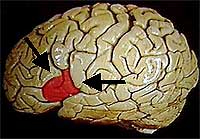 |
Wernicke's Area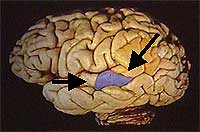 |
Images courtesy of Slice of Life.
Cerebral Dominance
Each hemisphere of the brain is dominant for other behaviors. For example, it appears that the right brain is dominant for spatial abilities, face recognition, visual imagery and music. The left brain may be more dominant for calculations, math and logical abilities. Of course, these are generalizations and in normal people, the two hemispheres work together, are connected, and share information through the corpus callosum. Much of what we know about the right and left hemispheres comes from studies in people who have had the corpus callosum split - this surgical operation isolates most of the right hemisphere from the left hemisphere. This type of surgery is performed in patients suffering from epilepsy. The corpus callosum is cut to prevent the spread of the "epileptic seizure" from one hemisphere to the other.
Dominant Functions
Left Hemisphere
- Language
- Math
- Logic
Right Hemisphere
- Spatial abilities
- Face recognition
- Visual imagery
- Music
Split-Brain Experiments
 Roger Sperry (who won the
Nobel prize in 1981) and Michael Gazzaniga are two neuroscientists who
studied patients who had surgery to cut the corpus callosum. These
studies are called "Split-Brain Experiments". After
surgery, these people appeared quite "normal" - they could walk, read,
talk, play sports and do all the everyday things they did before surgery.
Only after careful experiments that isolated information from reaching one
hemisphere, could the real effects of the surgery be determined.
Roger Sperry (who won the
Nobel prize in 1981) and Michael Gazzaniga are two neuroscientists who
studied patients who had surgery to cut the corpus callosum. These
studies are called "Split-Brain Experiments". After
surgery, these people appeared quite "normal" - they could walk, read,
talk, play sports and do all the everyday things they did before surgery.
Only after careful experiments that isolated information from reaching one
hemisphere, could the real effects of the surgery be determined.
Dr. Sperry used a tachistoscope to present visual information to one hemisphere or the other. The tachistoscope requires people to focus on a point in the center of their visual field. Because each half of the visual field projects to the opposite site of the brain (crossing in the optic chiasm), it is possible to project a picture to either the right hemisphere OR the left hemisphere.
 So, say a "typical"
(language in the LEFT hemisphere) split-brain patient is sitting down,
looking straight ahead and is focusing on a dot in the middle of a screen.
Then a picture of a spoon is flashed to the right of the dot. The visual
information about the spoon crosses in the optic chiasm and ends up in the
LEFT HEMISPHERE. When the person is asked what the picture was, the
person has no problem identifying the spoon and says "Spoon." However, if
the spoon had been flashed to the left of the dot (see the picture), then
the visual information would have traveled to the RIGHT HEMISPHERE. Now if
the person is asked what the picture was, the person will say that nothing
was seen!! But, when this same person is asked to pick out an object
using only the LEFT hand, this person will correctly pick out the spoon.
This is because touch information from the left hand crosses over to the
right hemisphere - the side that "saw" the spoon. However, if the person
is again asked what the object is, even when it is in the person's hand,
the person will NOT be able to say what it is because the right hemisphere
cannot "talk." So, the right hemisphere is not stupid, it just has little
ability for language - it is "non-verbal."
So, say a "typical"
(language in the LEFT hemisphere) split-brain patient is sitting down,
looking straight ahead and is focusing on a dot in the middle of a screen.
Then a picture of a spoon is flashed to the right of the dot. The visual
information about the spoon crosses in the optic chiasm and ends up in the
LEFT HEMISPHERE. When the person is asked what the picture was, the
person has no problem identifying the spoon and says "Spoon." However, if
the spoon had been flashed to the left of the dot (see the picture), then
the visual information would have traveled to the RIGHT HEMISPHERE. Now if
the person is asked what the picture was, the person will say that nothing
was seen!! But, when this same person is asked to pick out an object
using only the LEFT hand, this person will correctly pick out the spoon.
This is because touch information from the left hand crosses over to the
right hemisphere - the side that "saw" the spoon. However, if the person
is again asked what the object is, even when it is in the person's hand,
the person will NOT be able to say what it is because the right hemisphere
cannot "talk." So, the right hemisphere is not stupid, it just has little
ability for language - it is "non-verbal."
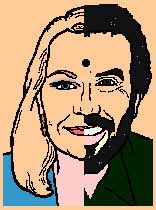 Another type of experiment performed with split brain patients uses
chimeric figures, like this one to the right. In this
figure, the face on the left is a woman and the face on the right is a
man. Therefore, if the patient focuses on the dot in the middle of the
forehead, the visual information about the woman's face will go to the
right cerebral hemisphere and information about the man's face will go to
the left hemisphere. When a split brain patient is asked to point to a
whole, normal picture of the face that was just seen, the patient will
usually pick out the woman's picture (remember, the information about the
woman's face went to the RIGHT cerebral hemisphere). However, if the
patient is required to say whether the picture was a man or a woman, the
patient will SAY that the picture was of a man. Therefore, depending on
what the patient is required to do, either the right or left hemisphere
will dominate. In this case, when speech is not required, the right
hemisphere will dominate for recognition of faces.
Another type of experiment performed with split brain patients uses
chimeric figures, like this one to the right. In this
figure, the face on the left is a woman and the face on the right is a
man. Therefore, if the patient focuses on the dot in the middle of the
forehead, the visual information about the woman's face will go to the
right cerebral hemisphere and information about the man's face will go to
the left hemisphere. When a split brain patient is asked to point to a
whole, normal picture of the face that was just seen, the patient will
usually pick out the woman's picture (remember, the information about the
woman's face went to the RIGHT cerebral hemisphere). However, if the
patient is required to say whether the picture was a man or a woman, the
patient will SAY that the picture was of a man. Therefore, depending on
what the patient is required to do, either the right or left hemisphere
will dominate. In this case, when speech is not required, the right
hemisphere will dominate for recognition of faces.
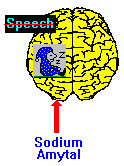 Before different types of
brain surgery, it is important to identify which cerebral hemisphere is
dominant for language so that the neurosurgeon can avoid damaging speech
areas. One way to test which hemisphere is dominant for language is with
a procedure called the Wada
Test. During this test, a fast acting anesthetic called sodium amytal
(amobarbital) is injected into the right or left carotid artery. The
right artery supplies the right cerebral hemisphere and the left artery
supplies the left cerebral hemisphere. Therefore, either the right or left
hemisphere can be "put to sleep" temporarily. If the left hemisphere is
put to sleep in people who have language ability in the left hemisphere,
then when asked to speak, they cannot. However, if the right hemisphere
is put to sleep, then these people will be able to speak and answer
questions. (Remember too that because the right hemisphere controls
muscles on the left side, people will not be able to move the left side of
their bodies.)
Before different types of
brain surgery, it is important to identify which cerebral hemisphere is
dominant for language so that the neurosurgeon can avoid damaging speech
areas. One way to test which hemisphere is dominant for language is with
a procedure called the Wada
Test. During this test, a fast acting anesthetic called sodium amytal
(amobarbital) is injected into the right or left carotid artery. The
right artery supplies the right cerebral hemisphere and the left artery
supplies the left cerebral hemisphere. Therefore, either the right or left
hemisphere can be "put to sleep" temporarily. If the left hemisphere is
put to sleep in people who have language ability in the left hemisphere,
then when asked to speak, they cannot. However, if the right hemisphere
is put to sleep, then these people will be able to speak and answer
questions. (Remember too that because the right hemisphere controls
muscles on the left side, people will not be able to move the left side of
their bodies.)
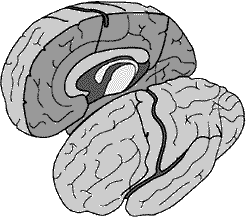 Another way to test for language representation in the brain is to
electrically stimulate the cerebral cortex. A neurosurgeon can place an
electrode on various areas of the exposed brain of an awake patient during
surgery. The patient can say what he or she feels and thinks. Placement
of the electrode on the brain does NOT hurt because the brain itself does
not have any receptors for pain. In people who have left side dominance
for language, electrical stimulation of various locations on the left
cerebral cortex will interfere with speech.
Another way to test for language representation in the brain is to
electrically stimulate the cerebral cortex. A neurosurgeon can place an
electrode on various areas of the exposed brain of an awake patient during
surgery. The patient can say what he or she feels and thinks. Placement
of the electrode on the brain does NOT hurt because the brain itself does
not have any receptors for pain. In people who have left side dominance
for language, electrical stimulation of various locations on the left
cerebral cortex will interfere with speech.
More information:
- Handedness and brain lateralization.
- Play the Split Brain Experiments Game from Nobelprize.org.
- Are you a left hander? If you are, then you have something in common with some famous people such as Barack Obama, Bill Clinton, Jimmy Connors, Angelina Jolie, Ronald Reagan, Kurt Cobain and Marilyn Monroe.
Copyright © 1996-2021, Eric H. Chudler All Rights Reserved.
